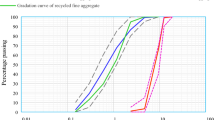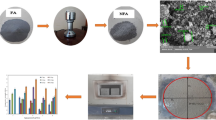Abstract
Placement of concrete in hot weather regions is a big challenging due to the thermal cracking and durability problems, and therefore cooling concrete is a common practice. Multiple methods have been used to control and reduce placement temperature of fresh concrete. This study assesses the liquid nitrogen (LN) cooling effects on the concrete microstructure alterations. Several mixtures of binary and ternary binders were produced in actual hot weather conditions to evaluate the complementary effects of the injected LN with fly ash and/or nanosilica-modified concrete mixtures. Investigated parameters include fly ash (up to 25%), nanosilica (up to 4%) and LN (up to 276 L/m3). Microstructural testing included the use of differential thermal analysis, scanning electron microscopy and X-ray diffraction. The results show that LN has a positive influence on the consumption of portlandite, especially in the nano-modified concretes, which could eliminate the propagation of further cracks and resulted in finer and denser internal microstructures. This finding encourages the use of LN cooling of pozzolanic materials in the mix design stages and avoids the overuse of cement in the summer session.








Similar content being viewed by others
References
Kjellsen, K.O.; Detwiler, R.J.; Gjørv, O.E.: Pore structure of plain cement pastes hydrated at different temperatures. Cem. Concr. Res. 20(6), 927–933 (1990). https://doi.org/10.1016/0008-8846(90)90055-3
Lothenbach, B.; Winnefeld, F.; Alder, C.; Wieland, E.; Lunk, P.: Effect of temperature on the pore solution, microstructure and hydration products of Portland cement pastes. Cem. Concr. Res. 37(4), 483–491 (2007)
Famy, C.; Scrivener, K.L.; Crumbie, A.K.: What causes differences of C-S-H gel grey levels in backscattered electron images? Cem. Concr. Res. 32(9), 1465–1471 (2002). https://doi.org/10.1016/S0008-8846(02)00808-6
Gallucci, E.; Zhang, X.; Scrivener, K.L.: Effect of temperature on the microstructure of calcium silicate hydrate (C-S-H). Cem. Concr. Res. 53, 185–195 (2013). https://doi.org/10.1016/j.cemconres.2013.06.008
Zacak, M.; Garrault, S.; Korb, J.P.; Nonat, A.: Effect of temperature on the development of CSH during early hydration of C3S. In: 12 th International Congress on the Chemistry of Cement, pp. W1–06 (2007)
Juenger, M.C.G.; Hema, J.; Solt, S.: The Effects of Liquid Nitrogen on Concrete Properties. Fhwa/Tx-08/0-5111-1, vol. 7, p. 120 (2007)
Lagundžija, S.; Thiam, M.: Temperature Reduction During Concrete Hydration in Massive Structures, pp. 1–118 (2017)
Malisch, W.: Comparing the options for cooling concrete. Concr. Prod. 15(5), 317–320 (1997)
Beaver, W.: Liquid nitrogen for concrete cooling. Concr. Int. Des. Constr. 9, 93–95 (2004)
Juenger, M.C.G.; Solt, S.M.; Hema, J.: Effects of liquid nitrogen cooling on fresh concrete properties. ACI Mater. J. 107(2), 123–131 (2010). https://doi.org/10.14359/51663575
Montgomery, D.C.; Myers, R.H.; Carter, W.H., Jr.; Vining, G.G.: The hierarchy principle in designed industrial experiments. Qual. Reliab. Eng. Int. 21(2), 197–201 (2005)
Ghafari, E.; Costa, H.; Júlio, E.: RSM-based model to predict the performance of self-compacting UHPC reinforced with hybrid steel micro-fibers. Constr. Build. Mater. 66, 375–383 (2014)
Sumodjo, J.G.F.: Precooling mass concrete with liquid nitrogen. Concr. Int. 34(7) 2012
Abayou, A.; Yasien, A.M.; Bassuoni, M.T.: Properties of nanosilica-modified concrete cast and cured under cyclic freezing/low temperatures. Adv. Civ. Eng. Mater. 8(3), 287–306 (2019). https://doi.org/10.1520/ACEM20190013
Said, A.M.; Zeidan, M.S.; Bassuoni, M.T.; Tian, Y.: Properties of concrete incorporating nano-silica. Constr. Build. Mater. 36, 838–844 (2012)
Kjellsen, K.O.; Monsøy, A.; Isachsen, K.; Detwiler, R.J.: Preparation of flat-polished specimens for SEM-backscattered electron imaging and X-ray microanalysis—importance of epoxy impregnation. Cem. Concr. Res. 33(4), 611–616 (2003). https://doi.org/10.1016/S0008-8846(02)01029-3
Ibrahim, R.K.; Hamid, R.; Taha, M.R.: Strength and microstructure of mortar containing nanosilica at high temperature. ACI Mater. J. 111(2), 163–170 (2014). https://doi.org/10.14359/51686497
Haruehansapong, S.; Pulngern, T.; Chucheepsakul, S.: Effect of the particle size of nanosilica on the compressive strength and the optimum replacement content of cement mortar containing nano-SiO2. Constr. Build. Mater. 50, 471–477 (2014)
Jaber, A.; Gorgis, I.; Hassan, M.: Relationship between splitting tensile and compressive strengths for self-compacting concrete containing nano- and micro silica. MATEC Web Conf. 162, 02013 (2018). https://doi.org/10.1051/matecconf/201816202013
Senff, L.; Labrincha, J.A.; Ferreira, V.M.; Hotza, D.; Repette, W.L.: Effect of nano-silica on rheology and fresh properties of cement pastes and mortars. Constr. Build. Mater. 23(7), 2487–2491 (2009)
Mehta PKAM, Monteiro P (2014) Concrete: microstructure, properties, and materials. McGraw-Hill Education
Mehta, P.K.: Effect of fly ash composition on sulfate resistance of cement. J. Proc. 83(6), 994–1000 (1986)
ส. ไทรทับทิม, “No Titleการนําสาหร่ายที่ผลิตน้ำมันไบโอดีเซลมาบําบัดน้ำเสียของ โรงงานอุตสาหกรรมรีไซเคิล,” 2554
Wongkeo, W.; Thongsanitgarn, P.; Chindaprasirt, P.; Chaipanich, A.: Thermogravimetry of ternary cement blends. J. Therm. Anal. Calorim. 113(3), 1079–1090 (2013)
Anjos, M.A.S.; Camões, A.; Campos, P.; Azeredo, G.A.; Ferreira, R.L.S.: Effect of high volume fly ash and metakaolin with and without hydrated lime on the properties of self-compacting concrete. J. Build. Eng. 27, 100985 (2020)
Sha, W.; O’Neill, E.A.; Guo, Z.: Differential scanning calorimetry study of ordinary Portland cement. Cem. Concr. Res. 29(9), 1487–1489 (1999)
Ramachandran, V.S.; Beaudoin, J.J.: Handbook of Analytical Techniques in Concrete Science and Technology: Principles, Techniques and Applications. Elsevier (2000)
Shui, Z.; Zhang, R.; Chen, W.; Xuan, D.: Effects of mineral admixtures on the thermal expansion properties of hardened cement paste. Constr. Build. Mater. 24(9), 1761–1767 (2010)
Esteves, L.P.: On the hydration of water-entrained cement–silica systems: combined SEM, XRD and thermal analysis in cement pastes. Thermochim. Acta 518(1–2), 27–35 (2011)
Aly, M.; Hashmi, M.S.J.; Olabi, A.G.; Messeiry, M.; Abadir, E.F.; Hussain, A.I.: Effect of colloidal nano-silica on the mechanical and physical behaviour of waste-glass cement mortar. Mater. Des. 33(1), 127–135 (2012). https://doi.org/10.1016/j.matdes.2011.07.008
Vedalakshmi, R.; Raj, A.S.; Srinivasan, S.; Babu, K.G.: Quantification of hydrated cement products of blended cements in low and medium strength concrete using TG and DTA technique. Thermochim. Acta 407(1–2), 49–60 (2003)
Shi, C.; Wang, D.; Wu, L.; Wu, Z.: The hydration and microstructure of ultra high-strength concrete with cement–silica fume–slag binder. Cem. Concr. Compos. 61, 44–52 (2015)
Hassan, M.S.; Jaber, I.N.G.A.A.: Fresh and hardened properties of nanosilica and microsilica contained self-consolidating concretes. ARPN J. Eng. Appl. Sci. 12(17), 5140–5153 (2017)
Alani, S.; Hassan, M.S.; Jaber, A.A.; Ali, I.M.: Effects of elevated temperatures on strength and microstructure of mortar containing nano-calcined montmorillonite clay. Constr. Build. Mater. 263, 120895 (2020)
Singh, L.P.; Ali, D.; Tyagi, I.; Sharma, U.; Singh, R.; Hou, P.: Durability studies of nano-engineered fly ash concrete. Constr. Build. Mater. 194, 205–215 (2019). https://doi.org/10.1016/j.conbuildmat.2018.11.022
Ashraf, M.; Khan, A.N.; Ali, Q.; Mirza, J.; Goyal, A.; Anwar, A.M.: Physico-chemical, morphological and thermal analysis for the combined pozzolanic activities of minerals additives. Constr. Build. Mater. 23(6), 2207–2213 (2009)
Wongkeo, W.; Chaipanich, A.: Compressive strength, microstructure and thermal analysis of autoclaved and air cured structural lightweight concrete made with coal bottom ash and silica fume. Mater. Sci. Eng. A 527(16–17), 3676–3684 (2010)
Gunasekara, C.; Sandanayake, M.; Zhou, Z.; Law, D.W.; Setunge, S.: Effect of nano-silica addition into high volume fly ash–hydrated lime blended concrete. Constr. Build. Mater. 253, 119205 (2020). https://doi.org/10.1016/j.conbuildmat.2020.119205
Schubert, P.: Carbonation behavior of mortars and concretes made with fly ash. Spec. Publ. 100, 1945–1962 (1987)
Kokubu, M.; Nagataki, S.: Carbonation of concrete with fly ash and corrosion of reinforcements in 20 year tests. Spec. Publ. 114, 315–330 (1989)
Nagataki, S.; Ohga, H.: Combined effect of carbonation and chloride on corrosion of reinforcement in fly ash concrete. Spec. Publ. 132, 227–244 (1992)
Atiş, C.D.: Accelerated carbonation and testing of concrete made with fly ash. Constr. Build. Mater. 17(3), 147–152 (2003)
Shi, H.; Xu, B.; Zhou, X.: Influence of mineral admixtures on compressive strength, gas permeability and carbonation of high performance concrete. Constr. Build. Mater. 23(5), 1980–1985 (2009)
Acknowledgements
The authors wish to thank the Civil Engineering Department, Concrete Lab, and Materials Lab of the University of Technology, Baghdad, Iraq, for extending their facilities for this research and also several on-going researches.
Author information
Authors and Affiliations
Corresponding author
Supplementary Information
Below is the link to the electronic supplementary material.
Rights and permissions
About this article
Cite this article
Kattoof, I., Hassan, M.S. & Hasan, S.S. Effects of Liquid Nitrogen Cooling on the Microstructure Properties of Nano-Modified Concrete Under Hot Conditions. Arab J Sci Eng 47, 12569–12583 (2022). https://doi.org/10.1007/s13369-021-06496-5
Received:
Accepted:
Published:
Issue Date:
DOI: https://doi.org/10.1007/s13369-021-06496-5




